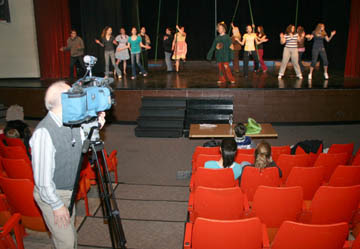

The Robotics team, "The Knights Of Alloy" 1535 kicked off the season on Jan. 5 when they receive there challenge for this year. The challenge is to build a robot that will grab a large ball and push it around a track while competing against other teams for points.
The team has 44 days to build and practice. There first competition is the regional in Waterloo during the Easter weekend. The team is made up of 27 students and a few teacher mentors. Eight local engineers do some mentoring and aid in design and building.
Top photo: Mr. Budau and Mr. Burmaster try out the game piece or track ball for size.
Second photo: Students present their ideas on design to the rest of the club members.
High School Robotics came to Sault Ste. Marie in 2001-02 when Korah Collegiate teachers coached the Sault’s first entry in the Canada First Robotics Competition season. We joined forces with Sault High (Michigan) to form Team #1596 – The International Instigators, and entered the US FIRST Circuit in 2004-05 Our entry (“Boomer”) won two regional bronze medals, a Rookie All-Star award and an invitation to the World FIRST robotics championship in Atlanta, Georgia. We finished that year 96th of 984 teams worldwide. In 2005-06, we placed in the top 25% of all teams at both regionals but did not advance to the World Finals. In 2006-07, we once again attended the World Championship event but did not place high enough to make the playoffs. Starting in 2007, our robotics team acted as hosts for the Sault’s first FIRST LEGO (FLL) regional, and have also added two FIRST Tech Challenge (FTC) robotics teams. We currently have the assistance of three teachers and eight engineering and professional mentors.
At the secondary level, students can join the smaller-scale FTC league or choose to join the FRC team or may even participate in both leagues.
FTC (VEX): This league begins in September and wraps up with a December Regional event. On Sept. 19th all participating teams learn the nature of the new year’s game contest and rules. They then have 12 weeks to build their custom-designed robots using a Meccano-type frame system, and this robot is brought with them to the Regional Championships in mid-December.
FRC: This team forms in late December and goes to a regional event in March. On January 5th, all participating FRC teams observe a NASA simulcast “Kick-off”, where we learn the nature of the new game contest and rules. Teams have exactly 44 days to engineer, build and test their competition robot. Our finished robot is shipped to the first regional event on day 44 and the team meets up with it when we arrive at the competition. All teams also create a team website (ours is
http://www.knightsofalloy.ca/) and a 30-second computer animated video movie.
During the build phase for either league, students join one or more of several engineering build teams that included: chassis design, drive-train, manipulator arms, electronics & programming, web-page and animation. Both teams also actively participate in various fundraising events – both as individual sales projects, and a major corporate sponsorship drive. We estimate that about 6000 student-hours go into the creation of both robots each year.
During a
Regional competition, our robot will compete in round-robin format and will be randomly teamed with other robots to compete in two-minute rounds against an opposing team of randomly selected robots. FTC plays a “2-on-2” format and FRC runs as a “3-on-3” format. Several rounds, each with new partners and new opponents will allow us to gain valuable win/loss points and are used to determine playoff qualifiers for that regional and will lead to the overall regional winner. The robots that make up a gold-medal winning team at a regional event earn a berth at the World Championships (mid-April in Atlanta, GA). Other World Championship invitations may also be earned by winning the Engineering award (for Robot design and manufacturing), or the Chairman’s award (for overall team dynamics).
We expect that about 1300 FRC teams from twelve countries will compete in one or more of 37 regional events in order to attempt to qualify for the Atlanta Championships. The newer FTC league should see about 800 teams competing in their circuit.
The Game Event:Each year, the event is totally new, with unique design requirements for each year. All teams are given the same basic starting kits but rigid rules must be followed for teams wishing to expand on this material. FTC teams may only use purchased VEX compatible materials. FRC teams must design and manufacture many of their own materials and are limited to their basic kits plus no more than $3500 in additional purchased or manufactured items.
The Knights of Alloy’s Robots:
The FRC robots generally weigh in at around 100 – 120 lbs, can measure 28” wide x 38” long x 48” tall and cost about $8000 each to build. The FTC robots must fit inside a cube of 18” sides but have no weight limit. A 2-person drive team commands each robot, while computer programming will allow them to control these machines via remote control. A variety of motors and sensors will also be used in the robot’s design and function.
Contact: Additional information can be obtained by contacting
Steve Burmaster (
burmass@adsb.on.ca),
Jonathan Budau (
budauj@email.adsb.on.ca), or
Rob Marshall (
marshar@email.adsb.on.ca)
by email or at Korah Collegiate (945-7180)


 Korah CO-OP students displayed and talked with fellow students about their first semester placements this Wednesday during the lunch period. There were many different career choices on display from web page design to food preparation, business, teaching and the trades.
Korah CO-OP students displayed and talked with fellow students about their first semester placements this Wednesday during the lunch period. There were many different career choices on display from web page design to food preparation, business, teaching and the trades.


































